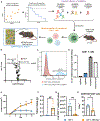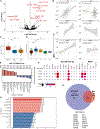A microRNA-regulated transcriptional state defines intratumoral CD8+ T cells that respond to immunotherapy
- PMID: 39951377
- PMCID: PMC11924119
- DOI: 10.1016/j.celrep.2025.115301
A microRNA-regulated transcriptional state defines intratumoral CD8+ T cells that respond to immunotherapy
Abstract
The rising incidence of advanced-stage colorectal cancer (CRC) and poor survival outcomes necessitate new and effective therapies. Immune checkpoint inhibitors (ICIs), specifically anti-PD-1 therapy, show promise, yet clinical determinants of a positive response are suboptimal. Here, we identify microRNA-155 (miR-155) as necessary for CD8+ T cell-infiltrated tumors through an unbiased in vivo CRISPR-Cas9 screen identifying functional tumor antigen-specific CD8+ T cell-expressed microRNAs. T cell miR-155 is required for anti-PD-1 responses and for a vital intratumor CD8+ T cell differentiation cascade by repressing Ship-1, inhibiting Tcf-1 and stemness, and subsequently enhancing Cxcr6 expression, anti-tumor immunity, and effector functions. Based on an underlying miR-155-dependent CD8+ T cell transcriptional profile, we identify a gene signature that predicts ICI responses across 12 diverse cancers. Together, our findings support a model whereby miR-155 serves as a central regulator of CD8+ T cell-dependent cancer immunity and ICI responses that may be leveraged for future therapeutics.
Keywords: CD8(+) T cell; CP: Cancer; CP: Immunology; Cxcr6; Ship-1; Tcf-1; anti-PD-1; biomarker; colorectal cancer; immune checkpoint inhibition; immunotherapy; microRNA-155.
Copyright © 2025 The Author(s). Published by Elsevier Inc. All rights reserved.
Conflict of interest statement
Declaration of interests A provisional patent was filed on October 10, 2024, that is related to the miR-155 gene signature being a predictor of responses to ICI (U-8545).
Figures







References
-
- Heinemann V, von Weikersthal LF, Decker T, Kiani A, Vehling-Kaiser U, Al-Batran SE, Heintges T, Lerchenmüller C, Kahl C, Seipelt G, et al. (2014). FOLFIRI plus cetuximab versus FOLFIRI plus bevacizumab as first-line treatment for patients with metastatic colorectal cancer (FIRE-3): a randomised, open-label, phase 3 trial. Lancet Oncol. 15, 1065–1075. 10.1016/S1470-2045(14)70330-4. - DOI - PubMed
MeSH terms
Substances
Grants and funding
LinkOut - more resources
Full Text Sources
Medical
Molecular Biology Databases
Research Materials
Miscellaneous

